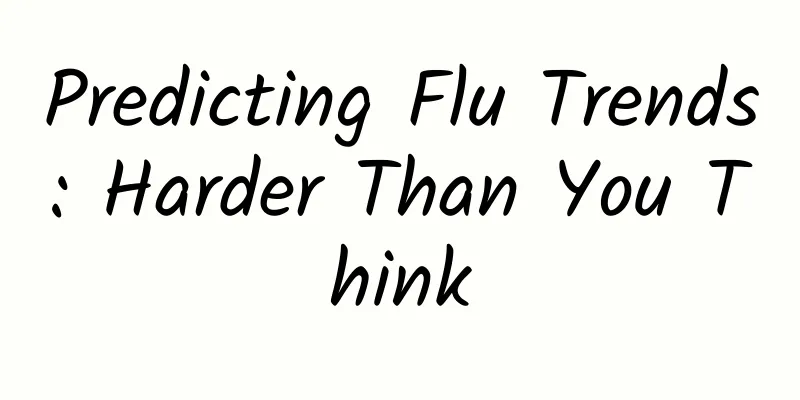Predicting Flu Trends: Harder Than You Think

|
Even if you were given a forecast now about the trend of respiratory diseases in the coming weeks, it would not be worth trusting. Written by Li Changqing (Doctor of Medicine, practicing physician in the United States) Every autumn and winter, respiratory clinics and wards are busy, especially pediatric clinics and wards. A large number of children with fever and cough fill pediatric wards, consulting rooms and corridors, making parents, children and medical staff miserable. As the first flu season after the COVID-19 epidemic prevention measures were relaxed, the situation this year is particularly serious. In addition to suffering, people want to know the answer to a question: How long will this trend last and when will it end? Flu season will eventually end, as will other respiratory disease outbreaks. But such answers are clearly unsatisfactory. People need to know the specific situation in the next week and the next month, including whether the number of patients with respiratory diseases will increase or decrease, by what magnitude, and how the situation will differ in each place. Not only do ordinary people care about these questions, but the answers are also particularly important for public health departments, which can help rationally allocate and supplement resources and take necessary epidemic prevention measures. For this reason, predicting trends in influenza and other seasonal epidemics has always been a hot topic in the public health profession. Take influenza as an example. Traditional predictions are based on past experience, summarizing the influenza situation in various places at a certain time each year in the past to predict the influenza epidemic this year or even a few years later. However, the influenza epidemic situation is different every year because this complex trend is affected by many factors. A slight change in one or several factors may lead to a huge trend difference. These factors include virus factors, vaccination status, seasonality, population (and mobility) factors, etc. Such a complex system cannot be predicted by simple data comparison, and needs to be analyzed with the help of complex mathematical models. Even with mathematical models, a large amount of accurate information needs to be input to make predictions, including the trend of outpatient visits for influenza-like patients in various regions, the positive detection of influenza virus in respiratory specimens, and the hospitalization of influenza-like patients. After the rise of the Internet, researchers came up with the idea of using social media and online searches to predict the prevalence of influenza. As early as 2013, the Centers for Disease Control and Prevention (CDC) in the United States launched an annual flu forecasting challenge, inviting technically qualified institutions to predict the prevalence of influenza in 1-4 weeks by analyzing online information. This year is the tenth year of this activity. As of November 27, a total of 22 teams have made 27 model predictions. Except for a few models, most models predict that flu cases and hospitalizations will continue to increase across the United States until December 9. The predictions of different models vary greatly: the number of daily case reports ranges from the current 4,000 to 2,900 to 10,000. The CDC summarizes a general trend based on these models. But even this summary trend may not be necessarily accurate. It is clear that even in regions and countries with relatively comprehensive data monitoring, it is quite difficult to accurately predict the trend of influenza. In view of this, it is probably difficult to predict the situation in China in the next few weeks. Especially considering that the pathogens prevalent this season are far more than just influenza viruses, there are also other pathogens such as rhinoviruses and respiratory syncytial viruses. Based on the existing information, it is not realistic to accurately predict the prevalence of respiratory diseases in the next few weeks. Even if someone guesses correctly, it is likely a guess, and it may not be correct next time. Even if a model that can accurately predict future trends emerges, it needs to input accurate and comprehensive epidemiological data to make predictions; prediction models based on social media and network information also need to be verified in different network environments. Ultimately, everything starts with improving public health infrastructure. This article is supported by the Science Popularization China Starry Sky Project Produced by: China Association for Science and Technology Department of Science Popularization Producer: China Science and Technology Press Co., Ltd., Beijing Zhongke Xinghe Culture Media Co., Ltd. |
<<: Why were Su Shi and Su Zhe buried in Jia County?
Recommend
Luxgen's new U6 SUV spy photos may be equipped with PSA engine
Recently, domestic media exposed a set of spy pho...
Tik Tok Kuaishou Ancient Painting and Singing Money Making Project
Douyin Kuaishou Ancient Painting Singing Money-Ma...
Artificial intelligence, “abandoning” real data sets?
Currently, artificial intelligence technology has...
World Mental Health Day丨Ding Dong! Please keep this guide to mental health care!
END Tadpole five-line score original work, please...
The leader of their migration is actually an airplane?
Right now, an incredible feat is taking place in ...
What is "Blue Starfish"? Introducing the Drifting Sea Steam Interface Buoy "Blue Starfish"
1. Introduction to Drifting Air-Sea Interface Buo...
Pre-installed apps on cheap Android phones pose serious security risks
In a study funded by the U.S. Department of Homel...
The whole process of user growth fission of "old bring new"
Without users, there is no revenue. In an era of ...
Mobile phone shooting and editing course: Use your mobile phone to shoot short videos with a movie feel
Mobile phone shooting and editing course: Use you...
Colorful marine plants, including giant kelp that is two to three hundred meters long!
Produced by: Science Popularization China Author:...
Is eating one egg a day good or bad for your health? Here's the latest research!
"Throw away the yolk of the egg, as the yolk...
Aurora erupts in Beijing, and there may be more tomorrow morning! Why does this astronomical wonder happen?
In the early morning of October 11, affected by t...
In-depth analysis of marketing: Why has Pinduoduo gained 300 million users in just three years?
We all know that it is not easy to survive in the...
2015: Will smartphones enter the borderless era?
CES2015 (International Consumer Electronics Show)...
How much does it cost to produce the Huainan women's clothing mini program? How much is the production cost of the Huainan women's clothing mini program?
According to industry insiders, mini programs wil...









